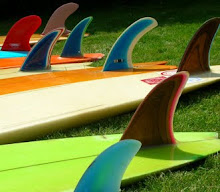
This little stunner was made at Freedom in Jersey ,probably shaped by Steve Harewood in '72 -'74. Its a very progressive shape for the time , 6 ft x 20 1/2,and was one of the first batch of twin fin fishes made over here. The classic outline is very familiar these days with the rebirth of retro keel fishes made in the hundreds and thousands ; this board actually knocked around the Gulf Stream factory for years and probably had a few templates taken from it.
In the winter of 1972 - summer of '73 UK boardmaking went through something of a tail revolution .The swallow tail - also called the split tail and the fish tail back then - was the new design to be seen on and offered alot of advantages for British waves. In the World championships in California in October '72, held in pretty junky surf, the new fish tail design had taken four top placings out of five, with Jimmy Blears 1st and David Nuuhiwa 2nd. Steve Harewood, who was in the British team at the time, scoped out these new shapes and started making them when he got back to Jersey. Soon he and fellow Worlds team mates Graham Nile, Pete Jones and Charles Williams were all riding Freedom fishes and swallow tails.
Benefits of fish tails at the time were advertised as -greater bite in critical situations in the wave and less spinning out (swallow tail), extra planeing area gives far greater speeds in mushy surf so greater manouverability in most UK conditions (fish). 'Putting the fun back into surfing, getting out of the narrow trips that just bog down in average waves ' . This all made a lot of sense - but there were some who went against the fish design. Tiki in '73 said the fish encourages a jerky style of surfing and is a step backwards from the long narrow singlefin, so wasn't something to get 'hooked' on.

After a winter of trials and test rides Freedom hit the marketplace in Summer '73 with a lot of progressive and stylish swallow tails and keel fishes , the latter of which didn't sell in great numbers because surfers were advised against them or found them hard to surf compared to the longer boards on the market. Nevertheless this is a sweet board and shows the quality of Steve's shaping. I don't think the underside spray job is original, and as for the keels - they look pretty experimentally made and I guess must be original. Pretty unusual colours on them. The bird decal was used on a lot of Freedoms from this early period.
 A sought after classic, early 70s John Conway from Henry's collection. Apart from making boards John is best known for starting Wavelength, the UK's longest running surf mag , taking loads of classic surf images which is now the Wavelength archive, and for bringing surfing professionalism into the UK through the world tour events held at fistral in the early 80s.
A sought after classic, early 70s John Conway from Henry's collection. Apart from making boards John is best known for starting Wavelength, the UK's longest running surf mag , taking loads of classic surf images which is now the Wavelength archive, and for bringing surfing professionalism into the UK through the world tour events held at fistral in the early 80s.


































































